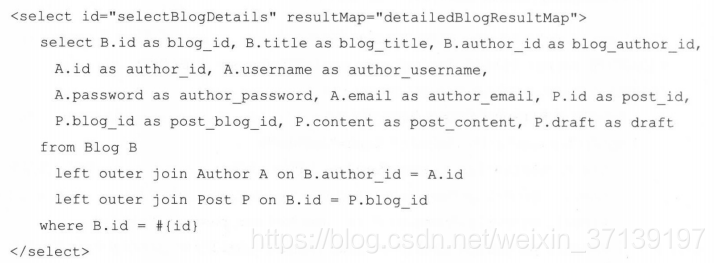1 两个基础类
在阅读本文之前, 最好能对这两个类有相应的理解。
1.1 列映射类ResultMapping
ResultMapping 对象记录了结果集中一列与队友JavaBean中一个属性的对应关系。

更多详情, 请参考mybatis百科-列映射类ResultMapping
1.2 结果集映射类ResultMap
ResultMap 对应的是结果集 ResultMapping 对象。
其组成大致如下:

更多详情, 请参考mybatis百科-结果集映射类ResultMap
2. 解析
2.1 入口函数
resultMap 是 mapper.xml 文件下的, 因此其是解析 Mapper 的一个环节。
resultMapElements(context.evalNodes("/mapper/resultMap"));
解析< **resultMap** >, 由于< **resultMap** >是可以有多个的, 因此, context.evalNodes("/mapper/resultMap")返回的是一个 List。
private void resultMapElements(List<XNode> list) throws Exception { // 遍历, 解析 for (XNode resultMapNode : list) { try { resultMapElement(resultMapNode); } catch (IncompleteElementException e) { // ignore, it will be retried } } }
2.2 解析流程
整个过程就是 resultMapElement 这个函数。其流程大体如下

对应的代码
private ResultMap resultMapElement(XNode resultMapNode) throws Exception { return resultMapElement(resultMapNode, Collections.<ResultMapping> emptyList()); } /** * 处理 <resultMap> 节点, 将节点解析成 ResultMap 对象, 下面包含有 ResultMapping 对象组成的列表 * @param resultMapNode resultMap 节点 * @param additionalResultMappings 另外的 ResultMapping 列 * @return ResultMap 对象 * @throws Exception */ private ResultMap resultMapElement(XNode resultMapNode, List<ResultMapping> additionalResultMappings) throws Exception { ErrorContext.instance().activity("processing " + resultMapNode.getValueBasedIdentifier()); // 获取 ID , 默认值会拼装所有父节点的 id 或 value 或 property String id = resultMapNode.getStringAttribute("id", resultMapNode.getValueBasedIdentifier()); // 获取 type 属性, 表示结果集将被映射为 type 指定类型的对象 String type = resultMapNode.getStringAttribute("type", resultMapNode.getStringAttribute("ofType", resultMapNode.getStringAttribute("resultType", resultMapNode.getStringAttribute("javaType")))); // 获取 extends 属性, 其表示结果集的继承 String extend = resultMapNode.getStringAttribute("extends"); // 自动映射属性。 将列名自动映射为属性 Boolean autoMapping = resultMapNode.getBooleanAttribute("autoMapping"); // 解析 type, 获取其类型 Class<?> typeClass = resolveClass(type); Discriminator discriminator = null; // 记录解析的结果 List<ResultMapping> resultMappings = new ArrayList<>(); resultMappings.addAll(additionalResultMappings); // 处理子节点 List<XNode> resultChildren = resultMapNode.getChildren(); for (XNode resultChild : resultChildren) { // 处理 constructor 节点 if ("constructor".equals(resultChild.getName())) { // 解析构造函数元素,其下的没每一个子节点都会生产一个 ResultMapping 对象 processConstructorElement(resultChild, typeClass, resultMappings); // 处理 discriminator 节点 } else if ("discriminator".equals(resultChild.getName())) { discriminator = processDiscriminatorElement(resultChild, typeClass, resultMappings); // 处理其余节点, 如 id, result, assosation d等 } else { List<ResultFlag> flags = new ArrayList<>(); if ("id".equals(resultChild.getName())) { flags.add(ResultFlag.ID); } // 创建 resultMapping 对象, 并添加到 resultMappings 中 resultMappings.add(buildResultMappingFromContext(resultChild, typeClass, flags)); } } // 创建 ResultMapResolver 对象, 该对象可以生成 ResultMap 对象 ResultMapResolver resultMapResolver = new ResultMapResolver(builderAssistant, id, typeClass, extend, discriminator, resultMappings, autoMapping); try { return resultMapResolver.resolve(); } catch (IncompleteElementException e) { // 如果无法创建 ResultMap 对象, 则将该结果添加到 incompleteResultMaps 集合中 configuration.addIncompleteResultMap(resultMapResolver); throw e; } }
2.3 获取 id
id 对于 resultMap 来说是很重要的, 它是一个身份标识。 具有唯一性
// 获取 ID , 默认值会拼装所有父节点的 id 或 value 或 property。 String id = resultMapNode.getStringAttribute("id", resultMapNode.getValueBasedIdentifier());
这里涉及到 XNode 对象中的两个函数
public String getStringAttribute(String name, String def) { String value = attributes.getProperty(name); if (value == null) { return def; } else { return value; } }
该函数是获取 XNode 对象对应 XML 节点的 name 属性值, 如果该属性不存在, 则返回传入的默认值 def 。
而在获取 id 的过程中, 默认值是下面这个函数
/** * 生成元素节点的基础 id * @return */ public String getValueBasedIdentifier() { StringBuilder builder = new StringBuilder(); XNode current = this; // 当前的节点不为空 while (current != null) { // 如果节点不等于 this, 则在0之前插入 _ 符号, 因为是不断的获取父节点的, 因此是插在前面 if (current != this) { builder.insert(0, "_"); } // 获取 id, id不存在则获取value, value不存在则获取 property。 String value = current.getStringAttribute("id", current.getStringAttribute("value", current.getStringAttribute("property", null))); // value 非空, 则将.替换为_, 并将value的值加上 [] if (value != null) { value = value.replace('.', '_'); builder.insert(0, "]"); builder.insert(0, value); builder.insert(0, "["); } // 不管 value 是否存在, 前面都添加上节点的名称 builder.insert(0, current.getName()); // 获取父节点 current = current.getParent(); } return builder.toString(); }
该函数是生成元素节点的id, 如果是这样子的 XML 。
<employee id="${id_var}"> <blah something="that"/> <first_name>Jim</first_name> <last_name>Smith</last_name> <birth_date> <year>1970</year> <month>6</month> <day>15</day> </birth_date> <height units="ft">5.8</height> <weight units="lbs">200</weight> <active>true</active> </employee>
我们调用
XNode node = parser.evalNode("/employee/height"); node.getValueBasedIdentifier();
则, 返回值应该是
employee[${id_var}]_height
2.4 解析结果集的类型
结果集的类型, 对应的是一个 JavaBean 对象。 通过反射来获得该类型。
// 获取type, type 不存在则获取 ofType, ofType // 不存在则获取 resultType, resultType 不存在则获取 javaType String type = resultMapNode.getStringAttribute("type", resultMapNode.getStringAttribute("ofType", resultMapNode.getStringAttribute("resultType", resultMapNode.getStringAttribute("javaType")))); // ... ... // 获取 type 对应的 Class 对象 Class<?> typeClass = resolveClass(type);
看源码, 有很多个 def 值, 也就是说, 我们在配置结果集的类型的时候都是有优先级的。 但是, 这里有一个奇怪的地方, 我源代码版本(3.5.0-SNAPSHOT)的
<!ELEMENT resultMap (constructor?,id*,result*,association*,collection*, discriminator?)> <!ATTLIST resultMap id CDATA #REQUIRED type CDATA #REQUIRED extends CDATA #IMPLIED autoMapping (true|false) #IMPLIED >
我怀疑是兼容以前的版本。
2.5 获取继承结果集和自动映射
String extend = resultMapNode.getStringAttribute("extends"); Boolean autoMapping = resultMapNode.getBooleanAttribute("autoMapping");
这个两个属性都是在配置 XML 的时候可有可无的。
2.6 解析 的子节点
先看 DTD 约束
<!ELEMENT resultMap (constructor?,id*,result*,association*,collection*, discriminator?)>
可以有以下几个子节点:
| 子节点 | 数量 |
|---|---|
| constructor | 出现 0 次或 1 次 |
| id | 出现 0 次或 多 次 |
| result | 出现 0 次或 多 次 |
| association | 出现 0 次或 多 次 |
| collection | 出现 0 次或 多 次 |
| discriminator | 出现 0次或 1 次 |
子节点解析过程很简单

根据类型进行解析, 最后获得 resultMappings (List),有可能会获得 discriminator(Discriminator)。
// 创建一个 resultMappings 的链表 List<ResultMapping> resultMappings = new ArrayList<>(); // 将从其他地方传入的additionalResultMappings添加到该链表中 resultMappings.addAll(additionalResultMappings); // 获取子节点 List<XNode> resultChildren = resultMapNode.getChildren(); // 遍历解析子节点 for (XNode resultChild : resultChildren) { if ("constructor".equals(resultChild.getName())) { // 解析构造函数元素,其下的没每一个子节点都会生产一个 ResultMapping 对象 processConstructorElement(resultChild, typeClass, resultMappings); } else if ("discriminator".equals(resultChild.getName())) { // 解析 discriminator 节点 discriminator = processDiscriminatorElement(resultChild, typeClass, resultMappings); } else { // 解析其余的节点 List<ResultFlag> flags = new ArrayList<>(); if ("id".equals(resultChild.getName())) { flags.add(ResultFlag.ID); } resultMappings.add(buildResultMappingFromContext(resultChild, typeClass, flags)); } }
除了 discriminator 节点, 其余节点最后都会回到 buildResultMappingFromContext 方法上, 该方法是创建 ResultMapping 对象。
/** * 获取一行, 如result等, 取得他们所有的属性, 通过这些属性建立 ResultMapping 对象 * @param context 对于节点本身 * @param resultType resultMap 的结果类型 * @param flags flag 属性, 对应 ResultFlag 枚举中的属性。 一般情况下为空 * @return 返回 ResultMapping * @throws Exception */ private ResultMapping buildResultMappingFromContext(XNode context, Class<?> resultType, List<ResultFlag> flags) throws Exception { String property; // 获取节点的属性, 如果节点是构造函数(只有name属性, 没有property), // 则获取的是 name, 否则获取 property if (flags.contains(ResultFlag.CONSTRUCTOR)) { property = context.getStringAttribute("name"); } else { property = context.getStringAttribute("property"); } String column = context.getStringAttribute("column"); String javaType = context.getStringAttribute("javaType"); String jdbcType = context.getStringAttribute("jdbcType"); String nestedSelect = context.getStringAttribute("select"); // 获取嵌套的结果集 String nestedResultMap = context.getStringAttribute("resultMap", processNestedResultMappings(context, Collections.<ResultMapping> emptyList())); String notNullColumn = context.getStringAttribute("notNullColumn"); String columnPrefix = context.getStringAttribute("columnPrefix"); String typeHandler = context.getStringAttribute("typeHandler"); String resultSet = context.getStringAttribute("resultSet"); String foreignColumn = context.getStringAttribute("foreignColumn"); boolean lazy = "lazy".equals(context.getStringAttribute("fetchType", configuration.isLazyLoadingEnabled() ? "lazy" : "eager")); // 以上获取各个属性节点 // 解析 javaType, typeHandler, jdbcType Class<?> javaTypeClass = resolveClass(javaType); @SuppressWarnings("unchecked") Class<? extends TypeHandler<?>> typeHandlerClass = (Class<? extends TypeHandler<?>>) resolveClass(typeHandler); JdbcType jdbcTypeEnum = resolveJdbcType(jdbcType); // 创建resultMapping对象 return builderAssistant.buildResultMapping(resultType, property, column, javaTypeClass, jdbcTypeEnum, nestedSelect, nestedResultMap, notNullColumn, columnPrefix, typeHandlerClass, flags, resultSet, foreignColumn, lazy); }
如果是 discriminator , 则处理该元素并创建鉴别器。
/** * 处理鉴别器 * @param context 节点 * @param resultType 结果类型 * @param resultMappings 列结果集合 * @return 鉴别器 * @throws Exception */ private Discriminator processDiscriminatorElement(XNode context, Class<?> resultType, List<ResultMapping> resultMappings) throws Exception { String column = context.getStringAttribute("column"); String javaType = context.getStringAttribute("javaType"); String jdbcType = context.getStringAttribute("jdbcType"); String typeHandler = context.getStringAttribute("typeHandler"); // 先获取各个属性 // 取得 javaType 对应的类型 Class<?> javaTypeClass = resolveClass(javaType); // 取得 typeHandler 对应的类型 @SuppressWarnings("unchecked") Class<? extends TypeHandler<?>> typeHandlerClass = (Class<? extends TypeHandler<?>>) resolveClass(typeHandler); // 取得 jdbcType 对应的类型 JdbcType jdbcTypeEnum = resolveJdbcType(jdbcType); // 创建 discriminatorMap, 并遍历子节点, 以 value->resultMap 的方式放入discriminatorMap中 Map<String, String> discriminatorMap = new HashMap<>(); for (XNode caseChild : context.getChildren()) { String value = caseChild.getStringAttribute("value"); String resultMap = caseChild.getStringAttribute("resultMap", processNestedResultMappings(caseChild, resultMappings)); discriminatorMap.put(value, resultMap); } // 创建鉴别器 return builderAssistant.buildDiscriminator(resultType, column, javaTypeClass, jdbcTypeEnum, typeHandlerClass, discriminatorMap); }
鉴别器内部, 也是含有 ResultMapping 的
public class Discriminator { private ResultMapping resultMapping; private Map<String, String> discriminatorMap; ...... }
2.7 创建 ResultMap 对象
在解析完 ResultMapResolver 对象, 通过对象可以生成 ResultMap。
/** * 创建并添加 ResultMap 到 Configuration 对象中 * @param id id, 配置了 id 可以提高效率 * @param type 类型 * @param extend 继承 * @param discriminator 鉴别器 * @param resultMappings 列集 * @param autoMapping 是否自动映射 * @return 返回创建的 ResultMap 对象 */ public ResultMap addResultMap( String id, Class<?> type, String extend, Discriminator discriminator, List<ResultMapping> resultMappings, Boolean autoMapping) { id = applyCurrentNamespace(id, false); extend = applyCurrentNamespace(extend, true); if (extend != null) { if (!configuration.hasResultMap(extend)) { throw new IncompleteElementException("Could not find a parent resultmap with id '" + extend + "'"); } // 从 configuration 中获取继承的结果集 ResultMap resultMap = configuration.getResultMap(extend); // 获取所集成结果集的所有 ResultMapping 集合 List<ResultMapping> extendedResultMappings = new ArrayList<>(resultMap.getResultMappings()); // 移除需要覆盖的 ResultMapping 集合 extendedResultMappings.removeAll(resultMappings); // 如果该 resultMap 中定义了构造节点, 则移除其父节点的构造器 boolean declaresConstructor = false; for (ResultMapping resultMapping : resultMappings) { if (resultMapping.getFlags().contains(ResultFlag.CONSTRUCTOR)) { declaresConstructor = true; break; } } if (declaresConstructor) { Iterator<ResultMapping> extendedResultMappingsIter = extendedResultMappings.iterator(); while (extendedResultMappingsIter.hasNext()) { if (extendedResultMappingsIter.next().getFlags().contains(ResultFlag.CONSTRUCTOR)) { extendedResultMappingsIter.remove(); } } } // 添加需要被继承的 ResultMapping 集合 resultMappings.addAll(extendedResultMappings); } // 通过建造者模式创建 ResultMap 对象 ResultMap resultMap = new ResultMap.Builder(configuration, id, type, resultMappings, autoMapping) .discriminator(discriminator) .build(); // 添加到 Configuration 对象中 configuration.addResultMap(resultMap); return resultMap; }
3 解析结果
有如下的数据库表

通过代码生成器生成 XML 和 Mapper。
添加结果集

对应的 sql

则最后解析出的结果











